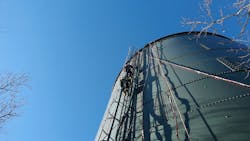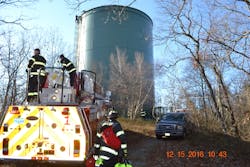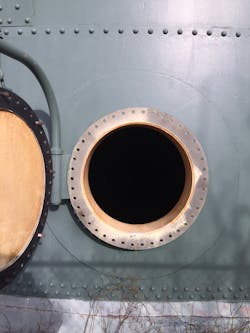Technical Rescue: Water Tank Rescue & Recovery
On Dec 15, 2016, the firefighters of the Braintree, MA, Fire Department reported to work expecting a routine day in the way of responses. The events that followed would lead to a rescue of two individuals and the recovery of a third from a water tank—a response that lasted over 18 hours. During the course of the rescue, there were issues, both operationally and environmentally, that constantly challenged the command staff, and the complexity of the water tank structure and the extreme cold temperatures compounded the already “normal” risks that all rescuers assume every day.
Understanding the rescue site
Built in 1925, the water tank sits on top of a hill and can be accessed via a dirt road in a congested neighborhood. The tank is about 65 feet tall with a dome-shaped roof, and from the top of the dome to where it meets the vertical wall of the tank is approximately 5 feet in height. The water level that day was at 57 feet, with the tank holding about 1 million gallons of water. The tank had been rehabbed a few years earlier and is routinely maintained; the community contracts out the tank’s cleaning and inspection.
To gain access to the top of the tank, there is a caged fixed ladder way that begins approximately 10 feet off the ground. To access this caged ladder way, a ground ladder must be placed under or next to the cage. The ladder on top of the tank does not have a cage and is used for inspection of the tank and access to a hatch at the top of the tank. It is held onto the dome of the tank by four small pieces of angle iron that have been there since the tank was installed. The hatch is square-shaped and measures approximately 22 inches by 20 inches.
Anchors were not present to tie off to for the workers entering the tank or for the later-arriving rescuers. This made finding adequate anchoring for fall protection and rescue/recovery operations difficult at best. The access hatch was about 20 inches from the edge of the tank, which presented access problems, as did the fact that the dome of the tank was pitched at about 30 degrees.
At the time of the incident, the tank was being cleaned and inspected by a company that inspects water tanks while they are still on line.
Size-up and initial actions
Police, fire and ambulance units were dispatched to the water tank located on Lincoln Street. Upon arrival, fire department members had to walk up a long dirt road where they were met with civilians yelling for help.
The weather was unusually cold that day, with the high temperature topping out at 28 degrees and the low temperature later that night bottoming out at 12 degrees. The winds whipped out of the west between 20 to 35 mph, with gusts up to 44 mph that night.
Members of Braintree’s Engine 3 climbed the narrow ladder to the top of the tank and made the difficult transition from the wall to the small roof ladder. They were met with three victims—the unresponsive diver who was now at the surface of the water, the diver’s coworker/spotter who had entered the water to aid the diver, and the diver’s 14-year-old son.
Once firefighters sized-up the situation, they determined that the 14-year-old boy was suffering from a panic attack. Lt. James Lochiatto and Firefighter Kevin Walsh aided him onto the wall ladder where he climbed down to awaiting medical personnel assisted by fire department personnel. At the same time, they secured the unresponsive diver, who they were holding up, to the fixed ladder via a rope that had been hastily put around his chest by the spotter. At this time, another rescuer arrived at the top of the tank with a rope bag to aid in the rescue. Additionally, the Southeastern Massachusetts Technical Rescue team was called in with members from the Norfolk County region responding initially, followed by team members from the Plymouth County region a few hours later to assist.
The diver’s spotter had climbed into the tank via a makeshift ladder to help the diver in ascending the ladder. This ladder was hung onto the opening via hooks on straps that were tied to the first and second rung of the ladder with clove hitches. When firefighters found the spotter in the water, he had a hold of the diver. Immediately, firefighters assisted the spotter out of the 47-degree water and onto the roof ladder. The spotter was not able to climb down the ladder due to hypothermia setting in and requested that he be lowered down. The fire department worked to warm him up by putting the diving victim’s coat on him and having the spotter place his hands inside his clothing to re-warm them to the point that he would be able to grab the rungs of the ladder.
A rope was fashioned into a lowering system using a Super Munter anchored to the beam of the ladder. It was attached to the spotter’s existing fall-arrest harness that he was wearing. He climbed down the ladder while most of his weight was being held by the rope system. He descended to the ground via the caged ladder way while another firefighter climbed down just below him to assist the spotter in his descent. He was immediately transported by Brewster Ambulance to South Shore Hospital to be treated for severe hypothermia.
Difficult decision
At this time, a decision was made to remove all members from the dome of the water tank, as they did not have adequate thermal or fall protection, and mild hypothermia was evident in the rescuers.
The fire chief, mayor, public works director and others then conferred to formulate the safest rescue plan going forward. Although a plethora of possible solutions came out of the meeting, it was finally deemed too risky to affect a quick rescue and thus the incident went from rescue to recovery mode.
Another factor that played into this decision was the time that had passed since the original 9-1-1 phone call. This was difficult decision for all involved, as everyone wanted the best outcome for the victim, David Scott of Texas. As Fire Chief James O’Brien told local media: “We were able to rescue one of the victims. We gave our best effort for the second victim, but partially through the rescue operation, we decided it was futile to put anyone else’s life in jeopardy CITATION Tru16 \l 1033 (Trufant, 2016).”
Recovery efforts
The recovery plan was to empty the approximately 1 million gallons of water from the elevated tank and then recover the diving victim’s body at the bottom of the tank. At the bottom of the water tank were two approximately 30-inch manholes that could be used for access once the covers were taken off. It was unknown how long the water would take to drain out of the tank.
Initially, it was lowered through a nearby hydrant that was opened. At approximately 8 p.m., it was deemed that the flow was slowing significantly. An engine was put on the hydrant to pump the water out of the elevated water tank. This presented its own challenges as the temperatures continued to drop, but with the efforts of everybody involved, the pumping operation continued for 8 hours.
As the meeting with command staff and community stakeholders was being conducted, members of Southeastern Massachusetts Technical Rescue Team (Norfolk region) started to arrive. The team is one of five regional technical rescue teams in the Commonwealth of Massachusetts. They are trained for rescues involving civilians stuck at heights and in confined spaces, trenches and collapsed buildings, among other specialized training. They were briefed and soon took the lead in the recovery operation, while working with Braintree Fire Department members, and under the fire department’s command staff.
The technical rescue team initially went to the top of the tower and secured a lowering system for the victim’s body to be lowered down as the water was drained from the tank. This would ensure that the victim would not get hung up in any of the equipment, including baffles, within the tank. At the same time, they brought a police department’s camera with them to take some pictures, which provided excellent situational awareness when conducting future briefings for squads that were going up onto the dome of the tank.
Technical rescue team squads regularly ascended the 60 feet to the top of the tower and monitored the lowering of the water and diver to the bottom. The squads were made of three to five members, with two being able to get on the dome and secure themselves, one being on the top of the ladder on the wall as a look out, and one being at the base of the ladder on the ground. All rescuers had double-legged shock-absorbing lanyards and were attached at all times. When one squad went up to the dome of the water tower, another squad was kept as a rapid-intervention team (RIT) at the base of the water tower.
The fire department along with the regional technical rescue teams worked until 4:26 a.m. the next morning to remove the diving victim in a safe and dignified manner. While there was about 2 feet of water remaining in the tank, rescuers entered the tank through one of the horizontal hatches in Mustang Immersion Suits, Class III harnesses and supplied air respirators. Atmospheric monitoring was constant, and a RIT team was staged at the rear 30-inch hatch.
While this was happening, the temperature dropped, and the winds picked up. Hypothermia was a high concern, and for that reason, the “working” time of the rescue squads on top of the tank was reduced to less than 10 minutes. The Boston Fire Department brought in heating and rehabilitation units, serving as a much-needed staging and heating area for the rescuers.
Lessons learned
Many valuable lessons were identified through this incident:
- Incident commanders (IC) must know when to call in specialized teams, such as hazmat response teams or technical rescue teams. Even though they are low-frequency/high-risk events, these teams bring the specialized skills, equipment and training needed for a successful outcome to incidents such as what happened in Braintree. In this case, the IC called in the regional technical rescue team almost immediately after the first engine arrived.
- Even though firefighters are masters of establishing order out of chaos on a daily basis, we must always be prepared for the unexpected. When a diver is unresponsive in an active water tank, that is unexpected. Sizing-up the scene and the situation are critical elements that not only need to happen initially, but continuously. With that, the personnel on scene must be updated on a regular basis as to what the incident action plan is, what the objectives are, and if anything has changed. An informed rescuer is a motivated rescuer.
- Make sure accountability is initiated and continued throughout the event. This is for all personnel on the scene from firefighters, police officers, and specialized teams. Personnel will come and go for various reasons such as a delayed response or a family emergency. It is imperative that there be an accurate count of responders at all times.
- Always have an ambulance standing by, not just for the victims involved in the incident, but for the rescuers, as something can always happen. All too often after the victims have been transported to the hospital or extricated out of the entrapment, the ambulance leaves with them. Call in another ambulance, if one is not already there, for the rescuers. At this incident, an ALS ambulance was kept on scene for the entire 18 hours. They were brought into each briefing/update and were proactively planning for hypothermia and other environmental injuries that may occur. Luckily, they were not needed.
Final thoughts
From start to finish, the rescue progressed seamlessly, from the fire department’s rescue operations to working with the Braintree Police Department and Massachusetts State Police in their initial investigation. Subsequently, OSHA did investigate TK Potable Diving of Texas and found several violations, which were later published in May 2017.
On that frigid day in December 2016, the response, rescue, recovery, and the fact that no rescuers were injured given the precarious circumstances, is a testament to the professionalism of emergency responders who are trained to help the public in their greatest time of need.
Reference
Trufant, J. "Crews work overnight to recover body from Braintree water tank." Patriot Ledger. Dec. 15, 2016.
Mark McCabe
Mark McCabe is a 30-year member of the fire service with experience in fire suppression, hazardous materials, fire prevention and fire instruction. Since 1993, he has been a fire instructor who teaches in all fire service subjects. McCabe specializes in the instruction of technical rescue and currently is the coordinator of Technical Rescue for the Massachusetts Firefighting Academy (MFA). As a current team leader of the Southeastern Massachusetts Technical Rescue Team, he responds to technical rescue incidents within the commonwealth of Massachusetts. For 24 years, McCabe was a rescue specialist and squad officer with FEMA’s Massachusetts Urban Search and Rescue team, having been deployed for incidents from natural disasters to the World Trade Center on 9/11. He is a certified Rescue Technician, Hazardous Materials Technician and EMT, and he holds numerous professional career certifications. McCabe earned his bachelor’s degree in fire science in 2017 and his master’s degree in public administration in 2018, both from Anna Maria College, and completed the Chief Fire Officer Training Program at the University of Massachusetts Edward J. Collins Jr. Center for Public Management in 2019 at the MFA.








